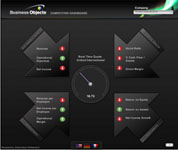Your business is up over 25% — great news! Or is it?
If the economy is also growing at 25%, you’re just keeping pace. And if your nearest competitor is up 50%, you’re losing market share…
Despite the millions invested in corporate information systems, what executives really care about isn’t the internal numbers, but how they compare to external benchmarks. They want to keep track of financial numbers (revenue, stock price, or return on capital), standard industry metrics (revenue per square foot of retail space), and, increasingly, non-financial metrics such as healthcare outcomes, customer satisfaction, and carbon footprints.
Gathering this benchmark data is a big industry, with major players such as Dun & Bradstreet for credit information, Hoovers for business reports, and Thomson for financial, healthcare, legal, and scientific information. And the rise of the “deep web” means that there are vast stores of information that could be used to benchmark almost every conceivable economic activity (imagine the benchmark potential of aggregate data from Amazon, Google, or eBay)
Comparing this information with internal data has been difficult. But data standards such as XBRL, web-services, and new information providers are transforming the possibilities.
External Information at Your Fingertips
New information providers focused on the BI market include eCompetitors, with data from 9,000 non-overlapping, strategically relevant industries. The “industries” are narrowly-defined, to allow real, business-relevant comparisons (for example, in the eCompetitor database, HP competes in 221 industries, Microsoft in 173). The goal is to allow organizations to “instantly generate customer-specific reports on their: competitors, business partners, business customers, and vendors, as well as a wide array of reports covering the global economy”.
Business Objects is also introducing a new site to make it easy to produce and consume benchmark data, called Information on Demand. The site uses Crystal Xcelsius technology to provide downloadable dashboards that make it easy to compare live information with just a few clicks. It features data from various providers, including the major players mentioned above, and lets organizations easily benchmark their performance against economic indicators, or against their direct competitors.
Images: examples of Downloadable Information on Demand Dashboards — Click to see interactive versions
How are you integrating external information into your BI 2.0 infrastructure?



Comments
One response to “How Am I Doing, Really? The Need for Information On Demand”
Business Objects announces Information OnDemand and IBM seeks Trademark protection
It might be a coincidence but Business Objects is about to launch Information OnDemand and IBM has just submitted trademark protection for the term “Information on Demand”.